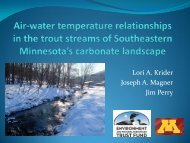Minnesota Water Resources Conference - Water Resources Center ...
Minnesota Water Resources Conference - Water Resources Center ...
Minnesota Water Resources Conference - Water Resources Center ...
Create successful ePaper yourself
Turn your PDF publications into a flip-book with our unique Google optimized e-Paper software.
BOOK OF ABSTRACTS<br />
Tuesday, Monday, October 27 23<br />
Poster Session 4:45–5:45<br />
Hydroxylated Polybrominated Diphenyl Ether Photolysis Quantum Yields and Product Identification<br />
Peter Steen, University of <strong>Minnesota</strong>, stee0219@umn.edu; William Arnold, University of <strong>Minnesota</strong>; Matthew Grandbois,<br />
University of <strong>Minnesota</strong>; Kristopher McNeill, University of <strong>Minnesota</strong><br />
Hydroxylated analogues of the ubiquitous polybrominated diphenyl ethers (PBDEs) have recently been found<br />
in surface waters, snow, rain, and wastewater/sewage treatment plant effluent. In addition to being natural<br />
products and known metabolites of PBDEs, OH-PBDEs are potentially produced during the wastewater<br />
treatment process. This study investigated the photolysis of 6-OH-BDE47 and three chlorinated derivatives,<br />
3-Cl-6-OH-BDE47, 5-Cl-6-OH-BDE47 and 3,5-Cl-6-OH-BDE47, which are hypothesized to be produced upon<br />
disinfection with chlorine. Quantum yields were determined for both the protonated and deprotonated species,<br />
and photoproducts were identified.<br />
The Future of Energy and <strong>Minnesota</strong>’s <strong>Water</strong> <strong>Resources</strong><br />
Sangwon Suh, University of <strong>Minnesota</strong>, sangwon@umn.edu; Laura Schmitt Olabisi, University of <strong>Minnesota</strong>; Yi-Wen Chiu,<br />
University of <strong>Minnesota</strong><br />
<strong>Minnesota</strong>’s water resources are poised to undergo significant changes in the coming decades. There is an<br />
urgent need to integrate an analysis of demands on <strong>Minnesota</strong>’s water resources with scenarios of future energy<br />
production. We are developing an integrated spatial model to analyze the future of MN’s water budget with<br />
particular attention to changes in water demand under different scenarios. Key trends incorporated into the<br />
scenarios include (1) biofuel production (considering water needs for irrigation of the biofuel feedstock as well<br />
as for processing); (2) changes in the electricity grid mix considering <strong>Minnesota</strong>’s Renewable Energy Standards;<br />
(3) demographic changes; and (4) climate change. We combine scenarios of water demand with GIS mapping<br />
and water balance techniques to deliver spatially and temporally explicit water budget projections for each<br />
scenario. Our findings will allow us to better understand the interactions between agricultural policy, energy<br />
policy, demographic changes and <strong>Minnesota</strong>’s water budget, so that policymakers can be better informed about<br />
how their decisions affect water resources. We present our initial findings through a series of maps depicting<br />
<strong>Minnesota</strong>’s potential spatial water budgets in the future.<br />
Citizen Stream Monitoring—Examples and Lessons Learned<br />
Bill Thompson, <strong>Minnesota</strong> Pollution Control Agency, bill.thompson@pca.state.mn.us<br />
Citizen stream monitoring (CSM) is an important component in many of <strong>Minnesota</strong>’s watershed and water<br />
quality improvement projects. It is useful for assessment, education, awareness-building, water quality data<br />
collection, and evaluation purposes. Volunteer data has been used to “fill-in-the-gaps” temporally and spatially.<br />
Several projects using CSM will be highlighted, including the Watonwan River <strong>Water</strong>shed and the Whitewater<br />
River <strong>Water</strong>shed. The dedication and resourcefulness of the many volunteers and local staff will be highlighted.<br />
Examples of the data that is produced, the information that is developed, and the lessons learned from various<br />
projects will be covered. Possible changes to improve upon some of the basic CSM formats will be introduced<br />
and assessed.<br />
53 <strong>Minnesota</strong> <strong>Water</strong> <strong>Resources</strong> <strong>Conference</strong>, October 27–28, 2008
















